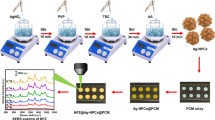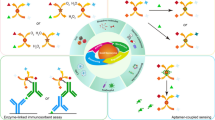Abstract
A colorimetric assay is described for acrylamide (AA). It is based on color changes induced by an increase in the distance between gold nanoparticles (AuNPs) that is caused by AA copolymerization. First, AuNPs were modified with a thiolated propylene amide poly(ethylene glycol) that also contains the AA functionality. The carbon-carbon double bonds on the modified AuNPs can be polymerized under the catalysis of a photoinitiator and under UV irradiation. This results in the aggregation of the AuNPs and in a color change from red to gray. In the presence of AA, the distance between the AuNPs increases due to copolymerization with AA, and the solution of AuNPs preserves its original red color. Under optimized conditions, the absorption ratio (A525/A740) of the solution increases linearly in the 1 nM to 10 μM free AA concentration range, with a 0.2 nM limit of detection. Hence, the method meets the need for rapid monitoring of trace AA in food. The method has a relative error (RSD) that is lower compared to the accepted HPLC method.

Schematic of a novel colorimetric strategy for acrylamide (AA) detection based on the increase of distance between gold nanoparticles (AuNPs) caused by AA participated polymerization.




Similar content being viewed by others
References
Mottram DS, Wedzicha BL, Dodson AT (2002) Acrylamide is formed in the Maillard reaction. Nature 419:448–449
Stadler RH, Blank I, Varga N, Robert F, Hau J, Guy PA, Robert MC, Riediker S (2002) Acrylamide from Maillard reaction products. Nature 419:449–450
(1994) IARC working group on the evaluation of carcinogenic risks to humans: some industrial chemicals. Lyon, 15–22. IARC Monogr Eval Carcinog Risks Hum 60:1–560
Besaratinia A, Pfeifer GP (2007) A review of mechanisms of acrylamide carcinogenicity. Carcinogenesis 28(3):519–528
WHO (2011) WHO/SDE/WSH/03.04/71/Rev/1
Tran NL, Barraj LM, Collinge S (2017) Reduction in dietary acrylamide exposure-impact of potatoes with low acrylamide potential. Risk Anal 37:1754–1767
Meghavarnam AK, Janakiraman S (2018) Evaluation of acrylamide reduction potential of l -asparaginase from Fusarium culmorum (ASP-87) in starchy products. LWT Food Sci Technol 89:32–37
Wang ZM, Wen C, Shi XB, Lu D, Deng JH, Deng FM (2017) Simultaneous inhibition of acrylamide and hydroxymethylfurfural formation by sodium glutamate microcapsules in an asparagine-glucose model system. J Food Sci Technol 54:572–577
Wen C, Shi XB, Wang ZM, Gao WL, Jiang LW, Xiao Q, Liu X (2016) Effects of metal ions on formation of acrylamide and 5-hydroxymethylfurfural in asparagine-glucose model system. Inter J Food Sci Technol 51:279–285
Kim SH, Hwang JH, Lee KG (2011) Analysis of acrylamide using gas chromatography-nitrogen phosphorus detector (GC-NPD). Food Sci Biotechnol 20:835–839
Shankar SS, Swamy BEK, Pandurangachar M, Chandra U, Chandrashekar BN, Manjunatha JG, Sherigara BS (2010) Electrocatalytic oxidation of dopamine on acrylamide modified carbon paste electrode: a Voltammetric study. Int J Electrochem Sci 5:944–954
Backe WJ, Yingling V, Johnson T (2014) The determination of acrylamide in environmental and drinking waters by large-volume injection - hydrophilic-interaction liquid chromatography and tandem mass spectrometry. J Chromatogr A 1334:72–78
Elbashir AA, Omar MMA, Ibrahim WAW, Schmitz OJ, Aboul-Enein HY (2014) Acrylamide analysis in food by liquid chromatographic and gas chromatographic methods. Crit Rev Anal Chem 44:107–141
Rashidi Nodeh H, Wan Ibrahim WA, Kamboh MA, Sanagi MM (2018) Magnetic graphene sol-gel hybrid as clean-up adsorbent for acrylamide analysis in food samples prior to GC-MS. Food Chem 239:208–216
Bertuzzi T, Rastelli S, Mulazzi A, Pietri A (2017) Survey on acrylamide in roasted coffee and barley and in potato crisps sold in Italy by a LC-MS/MS method. Food Addit Contam B 10:292–299
Abd El-Hady D, Albishri HM (2015) Simultaneous determination of acrylamide, asparagine and glucose in food using short chain methyl imidazolium ionic liquid based ultrasonic assisted extraction coupled with analyte focusing by ionic liquid micelle collapse capillary electrophoresis. Food Chem 188:551–558
Wu J, Shen YD, Lei HT, Sun YM, Yang JY, Xiao ZL, Wang H, Xu ZL (2014) Hapten synthesis and development of a competitive indirect enzyme-linked immunosorbent assay for acrylamide in food samples. J Agric Food Chem 62:7078–7084
Huang S, Lu S, Huang C, Sheng J, Zhang L, Su W, Xiao Q (2016) An electrochemical biosensor based on single-stranded DNA modified gold electrode for acrylamide determination. Sens Actuat B-Chem 224:22–30
Liu C, Luo F, Chen D, Qiu B, Tang X, Ke H, Chen X (2014) Fluorescence determination of acrylamide in heat-processed foods. Talanta 123:95–100
Hu Q, Xu X, Li Z, Zhang Y, Wang J, Fu Y, Li YB (2014) Detection of acrylamide in potato chips using a fluorescent sensing method based on acrylamide polymerization-induced distance increase between quantum dots. Biosens Bioelectron 54:64–71
Ma XY, Guo ZZ, Mao ZQ, Tang YG, Miao P (2018) Colorimetric theophylline aggregation assay using an RNA aptamer and non-crosslinking gold nanoparticles. Microchim Acta 185(33)
Ma CP, Wang FX, Wang XD, Han LZ, Jing H, Zhang H, Shi C (2017) A novel method to control carryover contamination in isothermal nucleic acid amplification. Chem Commun 53:10696–10699
Mao JP, Lu YX, Chang N, Yang JE, Yang JC, Zhang SC, Liu YY (2016) A nanoplasmonic probe as a triple channel colorimetric sensor array for protein discrimination. Analyst 141:4014–4017
Xie YH (2018) Colorimetric determination of Hg(II) via the gold amalgam induced deaggregation of gold nanoparticles. Microchim Acta 185:351
Huang PC, Li JF, Liu X, Wu FY (2016) Colorimetric determination of aluminum(III) based on the aggregation of Schiff base-functionalized gold nanoparticles. Microchim Acta 183:863–869
Du BB, Wang PL, Xiao C, Zhou Y, Wu L, Zhao H, Su XO, Yang J, He Y (2016) Antibody-free colorimetric determination of total aflatoxins by mercury(II)-mediated aggregation of lysine-functionalized gold nanoparticles. Microchim Acta 183:1493–1500
Huo Y, Qi L, Lv XJ, Lai T, Zhang J, Zhang ZQ (2016) A sensitive aptasensor for colorimetric detection of adenosine triphosphate based on the protective effect of ATP-aptamer complexes on unmodified gold nanoparticles. Biosens Bioelectron 78:315–320
Zhang YH, Wang YR, Zhu WX, Wang J, Yue XY, Liu W, Zhang DH, Wang JL (2017) Simultaneous colorimetric determination of bisphenol A and bisphenol S via a multi-level DNA circuit mediated by aptamers and gold nanoparticles. Microchim Acta 184:951–959
Borghei YS, Hosseini M, Dadmehr M, Hosseinkhani S, Ganjali MR, Sheikhnejad R (2016) Visual detection of cancer cells by colorimetric aptasensor based on aggregation of gold nanoparticles induced by DNA hybridization. Anal Chim Acta 904:92–97
Hou YH, Wang JJ, Jiang YZ, Lv C, Xia L, Hong SL, Lin M, Zhang ZL, Pang DW (2018) A colorimetric and electrochemical immunosensor for point-of-care detection of enterovirus 71. Biosens Bioelectron 99:186–192
Kumar D, Meenan BJ, Dixon D (2012) Glutathione-mediated release of Bodipy (R) from PEG cofunctionalized gold nanoparticles. Int J Nanomedicine 7:4007–4022
Kumar D, Mutreja I, Meenan BJ, Dixon D (2013) The profile of payload release from gold nanoparticles modified with a BODIPY (R)/PEG mixed monolayer. J Nanopart Res 25:16–30
Haiss W, Thanh NTK, Aveyard J, Fernig DG (2007) Determination of size and concentration of gold Nanoparticles from UV−Vis spectra. Anal Chem 79(11):4215–4221
Sun Z, Cui Z, Li H (2012) P-amino benzenesulfonic acid functionalized gold nanoparticles: synthesis, colorimetric detection of carbaryl and mechanism study by zeta potential assays. Sens Actuat B-Chemical 183:297–302
Flory PJ (1992) Principles of polymer chemistry, fifteenth printing. Cornell University press, New York, pp 246–256
Acknowledgments
The authors are grateful to the Natural Science Foundation of China (31301484), Natural Science Foundation of Hunan Province (2015JJ3082), Excellent Youth Foundation of Education Department of Hunan Province (17B124) and the Open Foundation of State Key Laboratory of Chemo/Biosensing and Chemometrics (Z2015025).
Author information
Authors and Affiliations
Corresponding authors
Ethics declarations
The author(s) declare that they have no competing interests.
Electronic supplementary material
ESM 1
(DOCX 330 kb)
Rights and permissions
About this article
Cite this article
Shi, X., Lu, D., Wang, Z. et al. Colorimetric and visual determination of acrylamide via acrylamide-mediated polymerization of acrylamide-functionalized gold nanoparticles. Microchim Acta 185, 522 (2018). https://doi.org/10.1007/s00604-018-3062-5
Received:
Accepted:
Published:
DOI: https://doi.org/10.1007/s00604-018-3062-5




